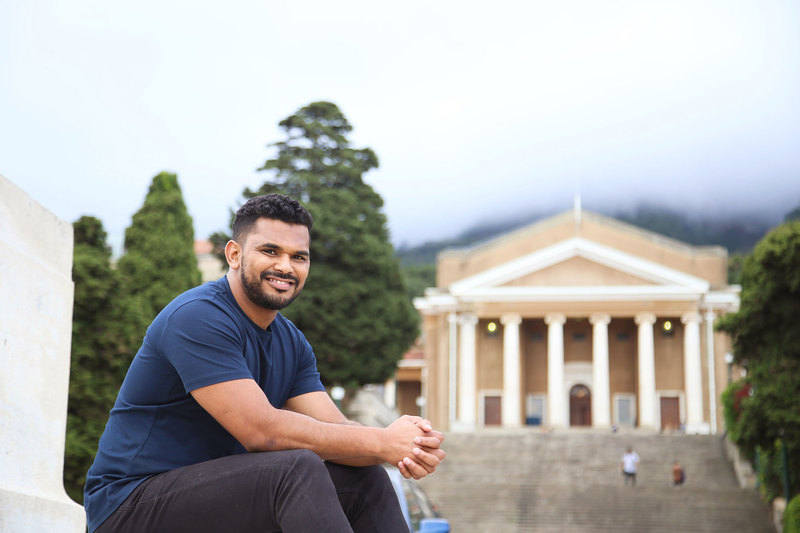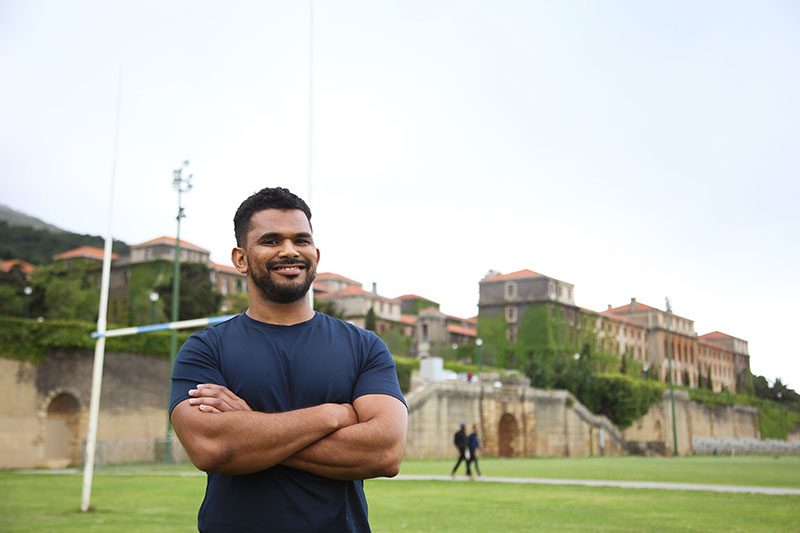Sharief Hendricks: rugby player, researcher and new member of the Future Professors Programme
13 April 2021 | Story Robert Morrell. Photo Je’nine May. Read time 4 min.
Dr Sharief Hendricks is a senior lecturer in the Division of Exercise Science and Sports Medicine (ESSM) in the Department of Human Biology in the Faculty of Health Sciences at the University of Cape Town (UCT) and a visiting fellow at Leeds Beckett University in the United Kingdom (UK). He was recently selected to be a member of the Future Professors Programme (FPP), an initiative of the Department of Higher Education and Training. He is also a member of the Next Generation Professoriate (NGP), joining 45 other UCT mid-career academic staff members in pursuit of promotion to the professoriate.
Becoming a sport and exercise science researcher
Sharief is proud of his origins and particularly grateful to his mom, who brought him up.
“I come from a family of fruit and veg hawkers, originally from District Six. What this meant is the notion of work, and working hard, was instilled in me from a young age. Even to this day, I feel a little bit of guilt when I’m taking a break or on leave. Thankfully though, I’ve come to realise the importance of time off for the creative process and staying productive.”

He grew up in a strong sporting family and community, with a particular passion for rugby and cricket.
“Like in most South African communities, sport was the alternative to all the bad stuff out there. Naturally, I fell in love with sports, and that love has influenced my decisions, which has brought us to where we are today.”
He registered for a BSc in Sport and Exercise Science at the University of the Western Cape in 2004, graduating cum laude in 2007. In 2006 he was selected to play scrum-half for the Western Province in the Under 21 Currie Cup. In 2008 he registered for an honours in physiology at the University of Cape Town (UCT). During that year he discovered the ESSM (then known as the UCT/MRC Research Unit for Exercise Science and Sports Medicine) where they were applying science to sport.
In 2009 he registered for an MSc within the division and upgraded to a PhD, graduating in 2012. A postdoc followed in 2013. In 2016 he was offered a research fellowship at Leeds Beckett University (UK), and in 2017 he registered for another postdoc at UCT, but in a slightly different field (health innovation).
Awards
Sharief was awarded a prestigious UCT Young Researcher Award in 2019 and was a finalist for the TW Kambule-NSTF Award (an award for South Africa’s top scientists). He was listed on the Mail & Guardian’s Top 200 Young South Africans (2019) and is currently a fellow of the European College of Sport Science. He is the social media editor for the European Journal of Sport Science and an associate editor for the Journal of Science and Medicine in Sport and BMJ Open Sport and Exercise Medicine (all top journals in the field).
He is president-elect of the South African Sports Medicine Association (the first non-physician to hold this position) and was recently voted chair of the South African Sports Confederation and Olympic Committee’s Sport Science, Technology and Research Commission in preparation for the 2024 Olympics.
“The [ESSM] (ranked 43rd in the world in terms of research), provided me with this environment to grow. The combination of autonomy and agency, guidance and support, and models of research and academic excellence that the ESSM has to offer is the stuff that keeps me inspired.”
Making a difference: linking research to policy
Sharief organises his research around two imperatives: improving player welfare and reducing the risk of injury while maximising performance in the tackle. This approach informs policy and drives the national injury prevention programme – SA Rugby’s BokSmart.
Sharief’s research has identified key risk factors for tackle injury and determinants of performance. His team has designed and developed novel training and testing equipment and programmes for the tackle.
One of his interests is to find the best ways of communicating his research and optimising stakeholder engagement. Sharief has studied how medical journals can use social media and other communication tools more effectively to share their published articles. As the social media editor for the European Journal of Sport Science for the past five years, Sharief has developed a number of innovations which other journals are now adopting.
Talking about his selection into the FPP and the NGP, he says: “I’m excited about the injection of opportunities these fellowships have to offer, and I look forward to meeting colleagues who are on the same academic journey that I am on.”
You can follow Sharief on Twitter, Instagram or LinkedIn.
 This work is licensed under a Creative Commons Attribution-NoDerivatives 4.0 International License.
This work is licensed under a Creative Commons Attribution-NoDerivatives 4.0 International License.
Please view the republishing articles page for more information.






